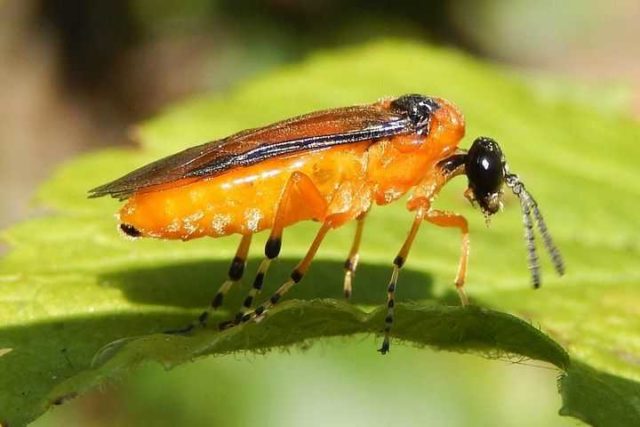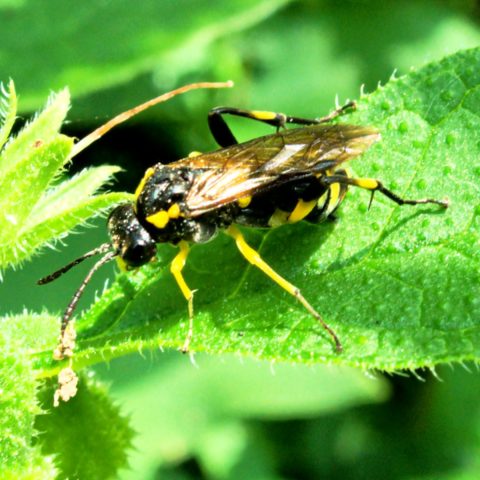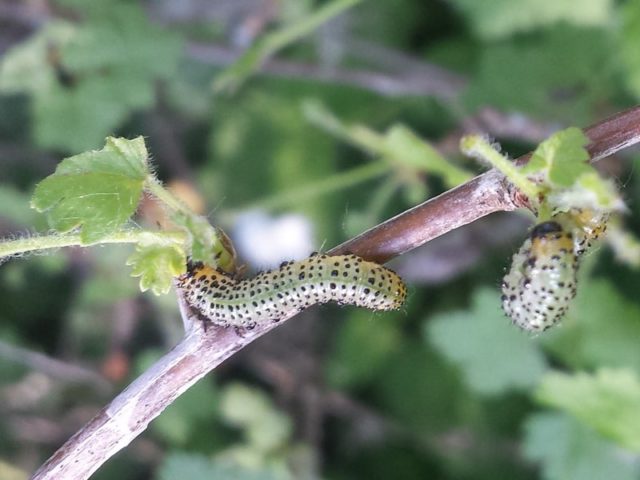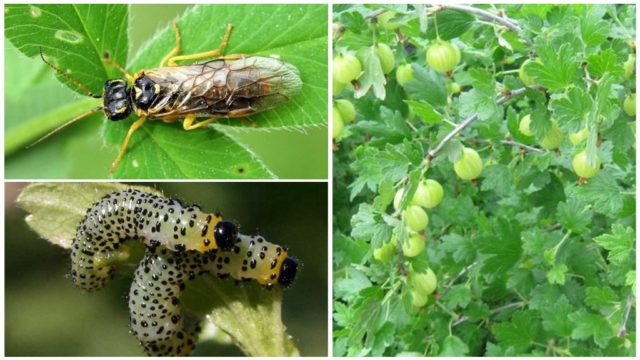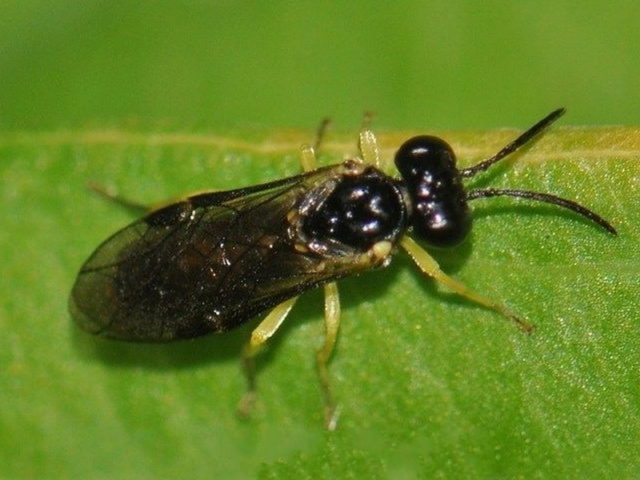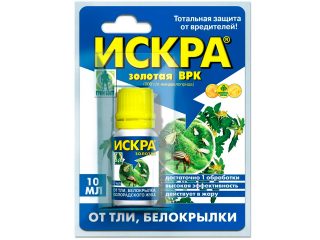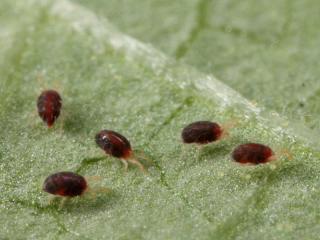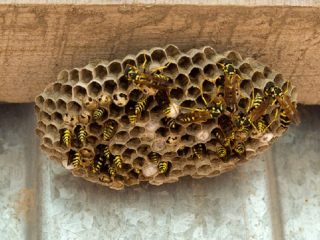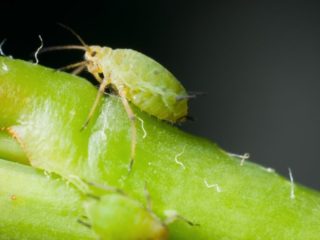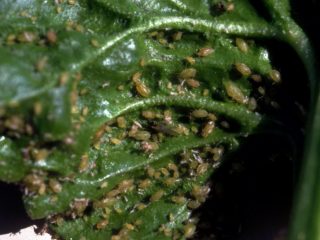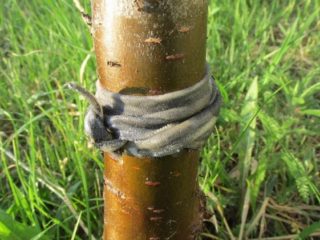Content
The gooseberry sawfly (lat. Nematus ribesii) is one of the most dangerous pests of gooseberry and currant bushes. If you do not fight the sawfly on gooseberries by carrying out recommended agrotechnical measures, then crop loss and plant death will be inevitable.
What does a gooseberry sawfly look like?
There are two types of pests: the yellow gooseberry sawfly and the pale-legged sawfly:
- Adults (adults) of the yellow sawfly are reddish-yellow in color;
- The second, pale-legged, type of dangerous beetle is black in color interspersed with light spots on the body and legs. The length of insects is no more than 8 mm.
In the larval stage, sawflies resemble their relatives, but, unlike them, they have not 8, but 10 pairs of legs. Experts call gooseberry sawfly larvae pseudocaterpillars. The color of yellow sawfly larvae is bluish-green, the insects are covered with black wart-like growths that grow up to 18 mm in length. At the same time, in the black sawfly they are smaller, no more than 1 cm, and green in color.
At the end of summer, the larvae go into the ground under the bushes to a depth of 6 - 12 cm, where they pupate and overwinter safely. With the arrival of spring, adult insects emerge from the pupae; their active phase coincides with the beginning of the flowering of red or black currants.
During this period, the young gooseberry leaves are just beginning to unfold, and the sawfly females begin laying eggs, cutting small depressions along the main vein of the leaf. Each female lays up to 60 eggs on the underside of leaves.
Sawfly larvae quickly appear and grow in the cuts - “pockets”. First they gnaw small holes, and then completely destroy the leaf blade. Sawfly larvae have five growth stages, each lasting 20 to 25 days. Then the insects fall to the ground and pupate. This is the first spring generation of the sawfly pest.
In just one summer in central Russia, 3–4 generations of sawfly manage to develop on gooseberries. The last generation leaves for the winter, the cocoon of its representatives is denser and darker than that of the summer one. Gooseberries need regular inspection of the leaves, since the fight against the sawfly must begin as early as possible.
What harm does the sawfly do to gooseberries?
Yellow and pale-legged gooseberry sawflies literally gnaw away the leaves of gooseberries and currants, leaving only the veins. They damage crops while in the larval phase. The second and fourth generations, that is, the summer representatives, are especially voracious and dangerous. It is not easy to remove the first layer of the parasite, but fighting the second and third generations takes even more time and effort.
The first generation usually goes unnoticed by gardeners. The first leaves that are eaten dry up without having time to grow, and there is no fight against the sawfly.However, the first generation, missed and not destroyed, gives birth to the second, which causes much more harm to the gooseberries.
The second generation flies out before the berries ripen, in mid-summer. It is the most numerous and causes the most significant harm. It happens that the fight against it begins too late. Insects attack currants and then move on to gooseberries. In one or two weeks, the bushes may be left without leaves, which weakens the plants, reduces growth and winter hardiness.
Due to sawfly damage, small, prematurely falling berries are formed. Heavy infestation by the pest reduces the productivity of bushes in the current year and prevents the formation of a future harvest. Having noticed signs of the presence of a sawfly, you need to immediately begin the fight. The third and fourth generations are smaller in number and develop mainly on gooseberries.
Methods for controlling gooseberry sawfly
The damage caused by sawflies to gooseberry bushes can be enormous if you do not fight and let everything take its course. You should regularly inspect the bushes in order to take timely measures and prevent pests from multiplying. The gooseberry sawfly damages gooseberries with foci and nests. The number of pests in different years can be more or less.
If such insects are found in a summer cottage, control measures must be taken urgently. Moreover, if you know the enemy of currants and gooseberries “in person” from the description and photo. Next year, comprehensive control should begin in early spring. This will significantly reduce subsequent summer troubles associated with the fight against the gooseberry sawfly.
Photo of gooseberry sawfly:
How to fight sawfly on gooseberries with folk remedies
Methods that have long been used by people are very good at destroying sawfly larvae, and at the same time other pests. These are mainly infusions or decoctions. For their preparation, substances and plants that are harmless to humans are used.
Traditional methods are good because they can be used at any time: during flowering, filling and ripening of berries. They do not kill beneficial insects or interfere with pollination. You can eat berries sprayed with folk remedies on the same day. They just need to be washed well.
In addition to the protective effect, many folk remedies simultaneously feed gooseberries. Due to this, the immunity of plants is increased, they grow better, become stronger and are less affected by pests.
Such treatments can be repeated after 7-10 days, and more often if necessary. It is useful to alternate treatments with ash and herbal infusions. Main means used:
- Infusion of tomato tops. It is prepared at the end of flowering (for this, the stepsons and lower leaves of tomatoes are taken): 1 kg of green mass is poured with boiling water and cooled. A solution of liquid laundry soap (50 ml) is added to the strained solution for better adhesion. This amount of infusion is enough for 2 - 3 bushes. Treatments can be repeated several times over the summer; they also kill aphids well.
- Ash infusion. Obtained from wood ash. Take 1 kg of sifted ash per 10 liters of hot water and leave for three days. The leaves are treated from the bottom and top sides with the filtered solution.
Currant and gooseberry bushes are also watered using sprinkling. After watering, sprinkle wood ash over the wet leaves. - Chamomile infusion. To prepare it, take 1 kg of medicinal chamomile plants, cut them and pour hot water. After infusion for 10 - 12 hours, filter the infusion and dilute it half and half with water. Add soap and spray the bushes.
- Infusion of wormwood. Prepare a remedy from 1.2 kg of grass in 10 liters of water. After three days of infusion, the infusion is filtered, 70 grams of baking soda are added and the plants are sprayed.
- Infusion of pine needles. 2 kg of coniferous branches are poured into a bucket and filled with water. Infuse for 6 - 8 days in the dark and filter. This is a concentrated product, before use it is diluted with water three to five times.
How to kill sawfly on gooseberries with chemicals
Chemicals should be used in the garden in critical cases, because some of the chemical gets into the berries.
During the period when buds appear on currants and gooseberries, they are sprayed with karbofos. To do this, take 75 g of powder per 10 liters of water.
The preparations “Iskra”, “Decis”, “Aktara”, “Konfidor”, “Kinmiks” help well against pests that eat leaves.
Chemicals can be applied in the evening and morning hours. At this time, the activity of beneficial entomophagous insects (ladybugs, hoverflies), which eat pest larvae, is reduced.
To prevent plants from getting chemical burns, in dry weather they need to be watered before spraying.
Mechanical measures to combat gooseberry sawfly
Among the mechanical methods of combating gooseberry pests, the following have proven effective:
- Before the buds open in the spring, you should shallowly loosen the soil under the currants and gooseberries, after scattering 2 cups of wood ash mixed with 1 tbsp around each bush. spoon of dry mustard and 1 tbsp. spoon of ground red pepper. Then you need to apply film or roofing felt under the bushes, the edges of which should be covered with earth. This method helps to simultaneously fight the gooseberry moth: adult individuals flying out of the pupae encounter an obstacle - the film and die under it.
- Hilling up is considered an effective way to destroy sawfly beetles flying out of the ground. To do this, you need to take soil from the rows or humus. The tree trunk circle under currants and gooseberries should be covered with a layer of pest-free soil to a height of 10 cm: sawflies will not be able to get out through such an obstacle.
- Throughout the season, it is important to shake off detected larvae onto the underlying film and destroy them. In addition, damaged berries containing the larva should be burned. For convenience, you can place a bucket of soapy water near a currant or gooseberry bush and throw insects into it.
- In the fall, it will be useful to re-dig the soil under the bushes. This measure will help destroy the larvae that have left for the winter.
Prevention measures
Each pest recognizes “its prey” by smell. Preventive methods of combating sawfly on gooseberries are aimed at repelling the parasite or “confusing it.” To prevent insects from smelling a plant that is attractive to them, plants with strong, overpowering aromas are planted around currants and gooseberries. In addition, you can place the source of the overpowering smell in a jar next to the bushes. Plants and substances that repel pests include:
- tansy;
- garlic;
- tomatoes;
- elderberry branches;
- tar;
- turpentine;
- creolin.
An effective method against sawflies are traps with pheromones: substances that, on the contrary, attract sawflies. Moving towards an attractive smell, the beetles end up on adhesive tape, from which they can no longer peel themselves off.
Conclusion
It is necessary to fight the sawfly on gooseberries quickly, paying attention in time to the first signs of the appearance of the pest - the first leaves of the bush eaten by its larvae. Afterwards, it is important to choose suitable control methods - folk or chemical plant protection products. The gooseberry sawfly is a very dangerous pest of currants and gooseberries, due to which the gardener may completely lose his berry harvest.
